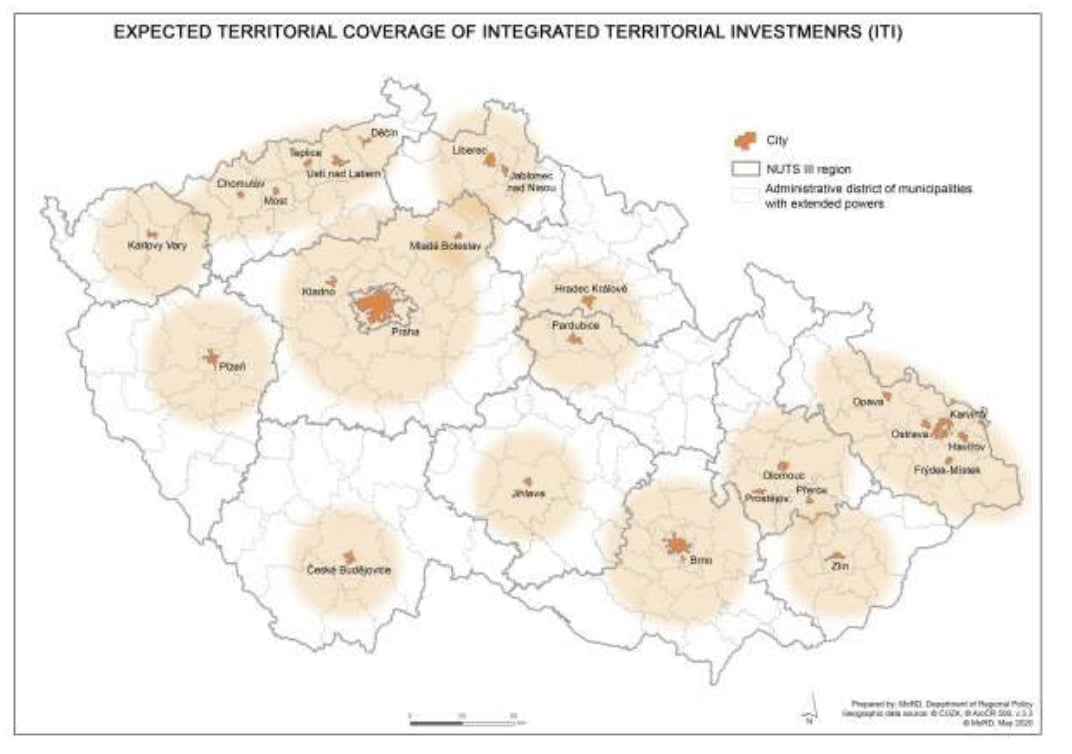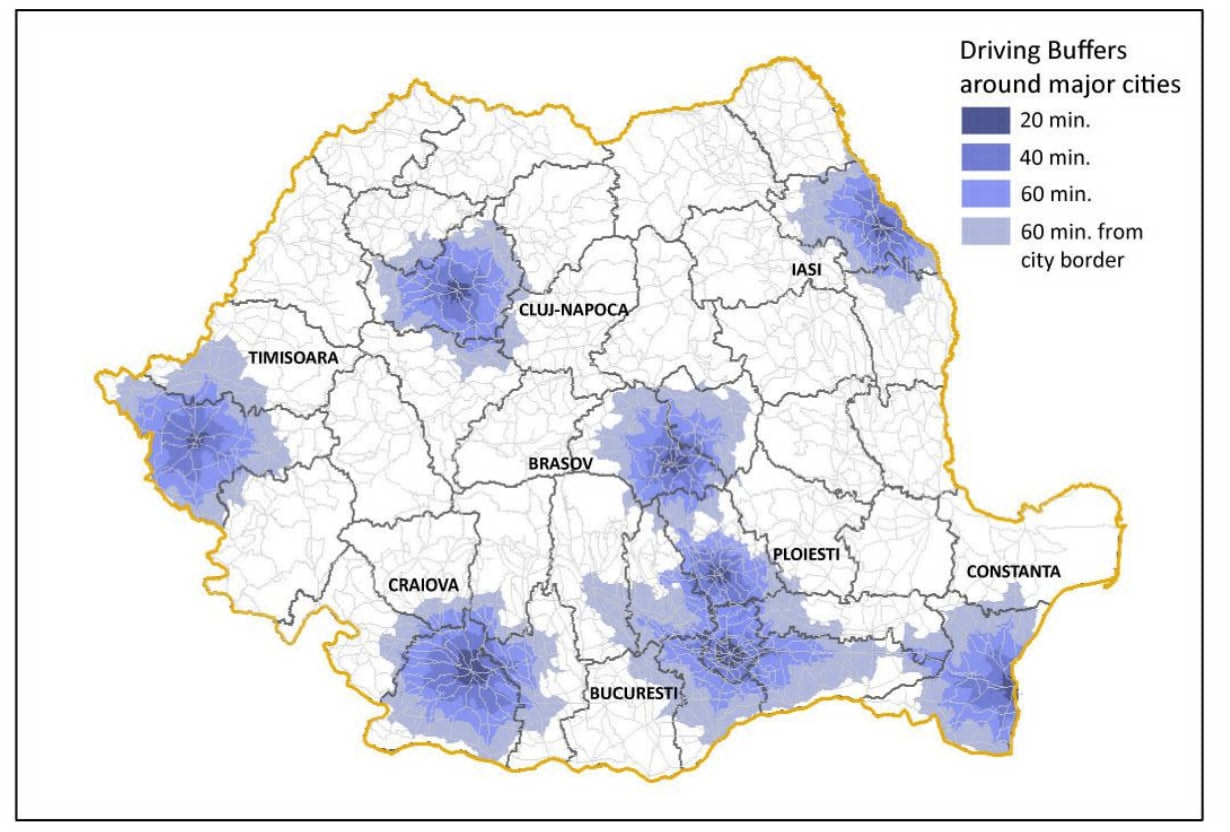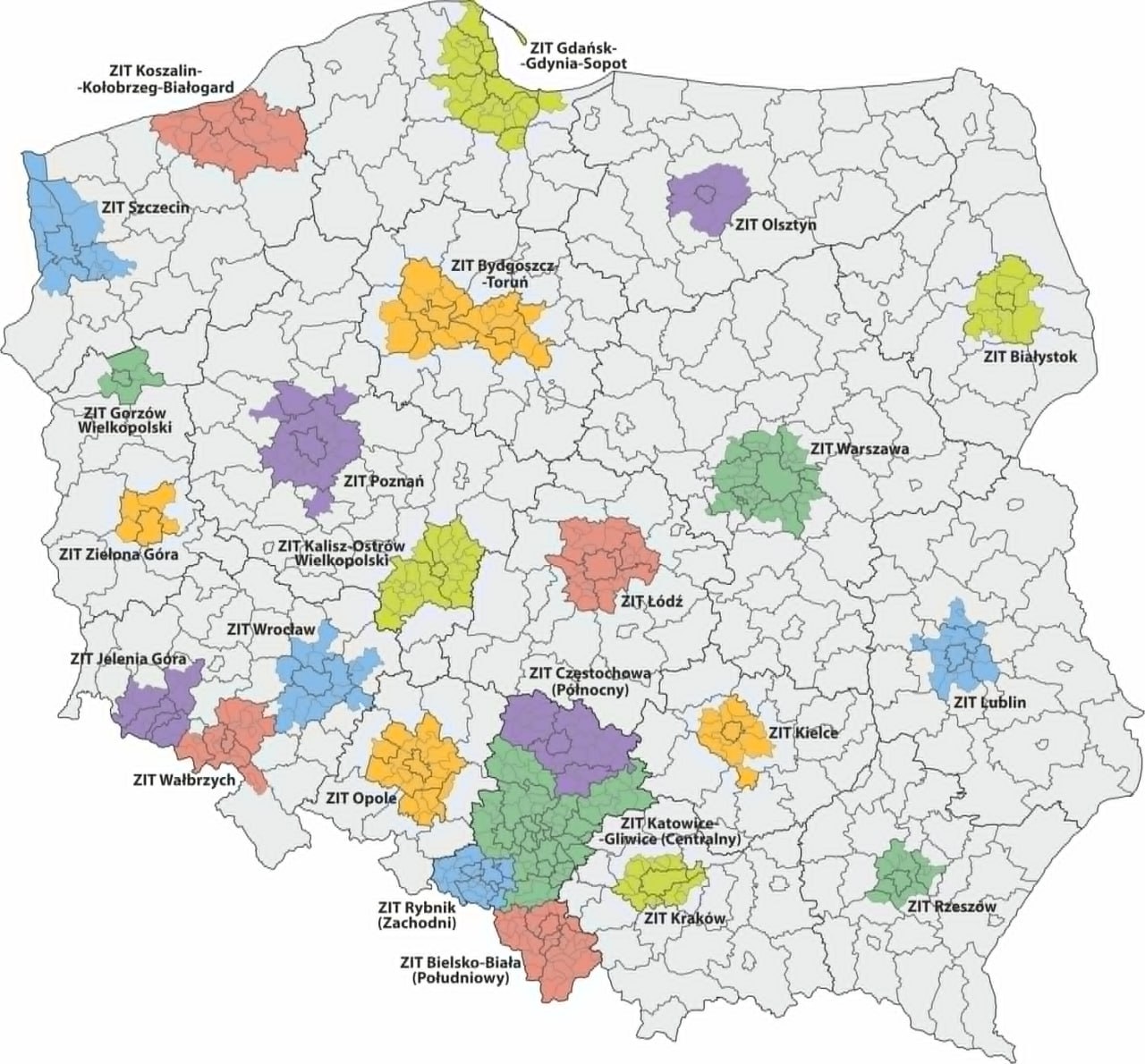HOW TO IGNITE ECONOMIC GROWTH USING EU REGIONAL POLICY TOOLS
Achieving the balance between spurring economic growth and eliminating territorial disparities is the art of regional policy. Almost every EU member state, particularly the less developed ones, has had to deal with these issues simultaneously (and in most cases still has to do!). Thus, the EU is continuously developing new ideas and effective tools, and we should learn from their experience on our way to European integration.
Functional urban areas
Let’s consider the concept of functional urban areas (FUA) in European regional policy. It differs from the concept of functional types of territories, which is common in Ukrainian regional policy, which is focused on similarity of territories (which may be set far apart across the country) by certain features, for example, mountainous or coastal. At the same time FUA concept always views territories as a group of functionally related and interdependent neighboring municipalities.
The idea of FUA is based on the notion that the development of functional ties always outperforms more conservative administrative division. Every morning various residents commute to other municipalities and return back home in the evening. Businesses build added value chains that involve their suppliers and partners from neighboring municipalities. The coverage areas of certain education or health care providers mostly go beyond the boundaries of one municipality, too. Municipalities are interconnected in local networks by public transport lines or engineering facilities, etc.
FUAs mostly grow around cities or a group of cities that not only influence the development of neighboring municipalities but also depend on them in means of their growth.
According to the EU and the OECD, a functional urban area encompasses a city and a “commuting zone”. Cities, in turn, are defined as administrative units with a population of 50,000 or more, where most of residents live in a so-called urban center with a high population density, while “commuting zones” are viewed as travel-to-work areas where at least 15% of employed residents commute to work in the respective city.
The FUA concept also finds itself in the basis of the definition of the so-called metropolitan regions. These include regions (urban agglomerations) with at least 50% of residents living in FUAs with a population of at least 250 000. To put it another way, agglomerations are generally equated with the FUAs, though larger.
This approach is noteworthy since it presupposes the alliance of both stronger (mostly urban) and weaker municipalities within one regional policy object, relying on their interconnection, where the stronger actually helps the weaker ones to catch up. In EU practice, the allotment of FUAs is based on pretty accurate statistics, i.e. data for each “pixel” of the European territory measuring 1 km2, which is generated and updated through population censuses. But even without those statistics, a similar approach can be applied in Ukraine while implementing a regional policy aimed to approximate the one in the EU.
Integrated territorial investments
Taking into consideration such functionally interconnected areas, the EU introduced the Integrated Territorial Investments (ITI) instrument within the 2014-2020 program period. It is based on the so-called integrated or Place-Based Approach, which is meant to develop areas mainly through unlocking their own potential. Meanwhile, the mechanism of multi-level governance should be involved in addressing development issues, meaning different levels of administration should be involved, namely national, regional, and local.
To apply for ITI resources, a group of functionally interconnected municipalities must primarily identify common problems and come with a common strategy and/or integrated development plan. Formalization of intentions regarding cooperation, represented as memoranda or inter-municipal associations, is a prerequisite.
To support the implementation of these integrated strategies, at least 5% of the funds in the previous and 8% of the funds in the current programming period that EU member states receive through the European Regional Development Fund were allocated through ITI and similar instruments.
Such strategies focus mainly on three key objectives:
- facilitating economic growth of the respective areas and preventing the outflow of labor resources from them (extremely relevant for Ukraine!)
- improving access to quality services for citizens regardless of their place of residence;
- strengthening the “connectivity” of the area – further reinforcement of its functional integrity through the development of road, transport, and engineering networks.
What exactly should we learn from this approach to rebuild and develop Ukrainian regions more effectively?
- An opportunity for extra funding is an incentive for the development of inter-municipal cooperation, which we currently lack. Representatives of the municipalities, who have experience in implementing ITI programs, while being interviewed as part of the study of economic growth poles initiated by the Ukraine-Moldova American Enterprise Fund and Civitta Company, stated that, having gained this experience, they continue to implement joint programs using their own resources without attracting external funding.
- A considerable number of community problems cannot be solved by those municipalities alone, that is why joint strategies/plans seem more realistic.
- Groups of municipalities applying for funding through ITI do not always cover the entire FUA, which boundaries are determined by statistical criteria. What matters is commitment to development cooperation, not administrative coercion.
- Even if they join forces, without government support municipalities often fail to solve problems that require significant investment. Such problems often appear as main drags to creating the basis for economic development of the respective areas (for example, providing investment sites with access to energy and utility networks, transport accessibility, etc.) and improving the quality of life of their residents, especially in relatively remote areas.
- Each of these functional areas defines its own specific assets and needs in its strategy. Targeted support here increases the chances that public investments will have a greater impact.
- The ITI tool implies that relevant investments can be made from diverse programs and funds and should simultaneously meet several operational objectives. In Ukraine, funding from different government programs is often not coordinated, which makes it difficult to achieve synergies.
Encouraging cooperation between stronger and weaker municipalities functionally related within FUA through the use of ITI-like instruments is an illustration of how both the problems of spurring economic growth and eliminating regional disparities can be addressed simultaneously.
Experience of some countries on the path to European integration
To some extent the concept of an integrated approach inherits and supplements the approach of the so-called growth poles (or centers), used for the postwar recovery of France. Both approaches aim to solve two problems at once. Let's take a closer look at the examples of an integrated approach in neighboring countries like Romania, the Czech Republic, and Poland.
The goal of Romania's Growth Pole Stimulation Program, launched in the 2007-2013 program period, was to "deconcentrate" the country's economic and social development, where its capital, Bucharest, largely dominated. Seven growth poles were identified as the centers of their respective regions and the cities with the highest economic performance in the region. They built voluntary partnerships with neighboring municipalities within a 30 km radius. Also, there were identified another 13 urban development poles with a population of 40,000 or more.
The country allocated 50% of its EU structural funds to support the growth poles. These funds were used to implement integrated strategies that directed the use of these resources. It was expected that by concentrating resources, the welfare created by these economic drivers would cover neighboring territories and eventually to the entire region. When planning a new program period, the development of these territories was based on the already implemented ITI tool.
The Regional Development Strategy of the Czech Republic 2021+ is based on an integrated approach. It implies that the instruments of government intervention are not applied equally across the entire state. Instead, they have different goals or are implemented differently in different territories. To implement this approach, five types of territories are distinguished. Metropolitan areas (Prague, Brno, and Ostrava) are assigned the role of nation’s economic drivers, while agglomerations and (sub)regional centers are meant to impact the respective surrounding territories.
The development of each type of such territories is viewed there as a separate strategic goal with its own operational objectives in the economic, infrastructure, social and environmental spheres.

To apply the ITI tool in the 2014-2020 program period, Poland has identified 24 cities with their surrounding areas, of which 17 are the centers of provinces (voievodstvos). EUR 6.2 billion was allocated for their development, including EUR 3.8 billion from EU structural funds. A prerequisite for raising funds was the formalization of cooperation between the respective centers and neighboring municipalities (gminas) in the form of associations or memoranda.
This approach is also being applied in the current program period, and experts from the Krakow Institute for Urban and Regional Development offer to supplement the selected growth poles, viewed as economic development drivers, by 54 more development balancing centers to mitigate territorial disparities.
How to launch the economic growth poles in Ukraine?
It is clear that the time has come to tackle the challenge of stimulating economic growth and overcoming territorial disparities within national regional policy. The solution to these problems must not be viewed as a choice between two separate approaches, but rather as two complementary tools.
The EU recommendations set the guideline. "Regional policy in the EU is the main instrument for reducing regional disparities and investing in sustainable and inclusive socio-economic growth," the European Commission states in Ukraine 2023 Report on its progress in implementing the requirements of the chapters included in the list of negotiated ones in the European integration process.
The path of EU member states demonstrates that an approach based on growth poles (centers) of various levels (key agglomerations, regional and subregional growth poles) is actually inevitable. Each of these poles must be viewed not as a separate city (community), but as a FUA. There must be specific incentive programs aimed at the development of such multilevel functional urban areas and the fulfillment of their functions in course of the national, regional, or local economy development.
While we do not have direct access to EU structural funds, it is clear that the mechanism for such incentives resembling the ITI instrument can be built at the national level. This means not only identifying specific lines of support for different types of growth poles, but also synergizing sectoral programs based on a place-based approach.
Funding for the poles must be provided at least on a medium-term basis (3-5 years). To attract it, functionally interconnected neighboring municipalities must develop joint (integrated) strategies/plans with a list of key projects aimed at boosting economic development, strengthening functional ties, and improving access to services for residents.
This approach can also facilitate a more effective solution to local recovery challenges, when affected municipalities will not be limited to government support only, but will be also supported by neighboring partner municipalities from their common functional group.
Please select it with the mouse and press Ctrl+Enter or Submit a bug
















 Login with Google
Login with Google